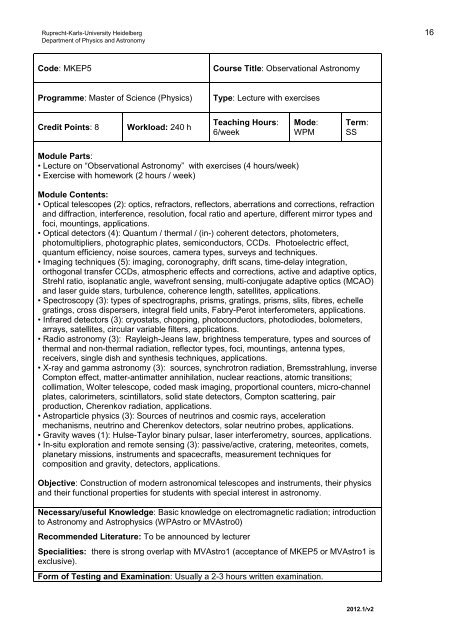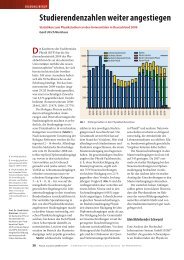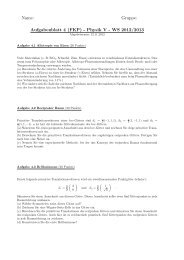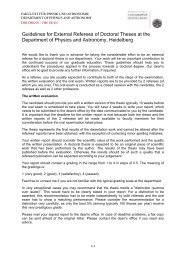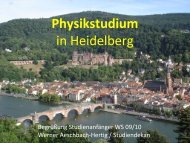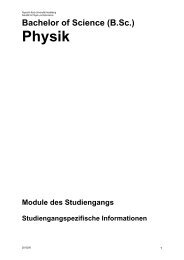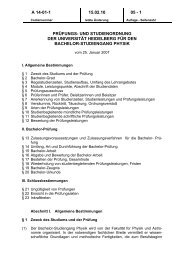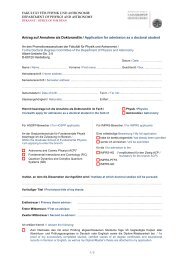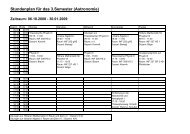Master - Fakultät für Physik und Astronomie
Master - Fakultät für Physik und Astronomie
Master - Fakultät für Physik und Astronomie
You also want an ePaper? Increase the reach of your titles
YUMPU automatically turns print PDFs into web optimized ePapers that Google loves.
Ruprecht-Karls-University Heidelberg 16<br />
Department of Physics and Astronomy<br />
Code: MKEP5<br />
Course Title: Observational Astronomy<br />
Programme: <strong>Master</strong> of Science (Physics)<br />
Type: Lecture with exercises<br />
Credit Points: 8<br />
Workload: 240 h<br />
Teaching Hours:<br />
6/week<br />
Mode:<br />
WPM<br />
Term:<br />
SS<br />
Module Parts:<br />
• Lecture on “Observational Astronomy” with exercises (4 hours/week)<br />
• Exercise with homework (2 hours / week)<br />
Module Contents:<br />
• Optical telescopes (2): optics, refractors, reflectors, aberrations and corrections, refraction<br />
and diffraction, interference, resolution, focal ratio and aperture, different mirror types and<br />
foci, mountings, applications.<br />
• Optical detectors (4): Quantum / thermal / (in-) coherent detectors, photometers,<br />
photomultipliers, photographic plates, semiconductors, CCDs. Photoelectric effect,<br />
quantum efficiency, noise sources, camera types, surveys and techniques.<br />
• Imaging techniques (5): imaging, coronography, drift scans, time-delay integration,<br />
orthogonal transfer CCDs, atmospheric effects and corrections, active and adaptive optics,<br />
Strehl ratio, isoplanatic angle, wavefront sensing, multi-conjugate adaptive optics (MCAO)<br />
and laser guide stars, turbulence, coherence length, satellites, applications.<br />
• Spectroscopy (3): types of spectrographs, prisms, gratings, prisms, slits, fibres, echelle<br />
gratings, cross dispersers, integral field units, Fabry-Perot interferometers, applications.<br />
• Infrared detectors (3): cryostats, chopping, photoconductors, photodiodes, bolometers,<br />
arrays, satellites, circular variable filters, applications.<br />
• Radio astronomy (3): Rayleigh-Jeans law, brightness temperature, types and sources of<br />
thermal and non-thermal radiation, reflector types, foci, mountings, antenna types,<br />
receivers, single dish and synthesis techniques, applications.<br />
• X-ray and gamma astronomy (3): sources, synchrotron radiation, Bremsstrahlung, inverse<br />
Compton effect, matter-antimatter annihilation, nuclear reactions, atomic transitions;<br />
collimation, Wolter telescope, coded mask imaging, proportional counters, micro-channel<br />
plates, calorimeters, scintillators, solid state detectors, Compton scattering, pair<br />
production, Cherenkov radiation, applications.<br />
• Astroparticle physics (3): Sources of neutrinos and cosmic rays, acceleration<br />
mechanisms, neutrino and Cherenkov detectors, solar neutrino probes, applications.<br />
• Gravity waves (1): Hulse-Taylor binary pulsar, laser interferometry, sources, applications.<br />
• In-situ exploration and remote sensing (3): passive/active, cratering, meteorites, comets,<br />
planetary missions, instruments and spacecrafts, measurement techniques for<br />
composition and gravity, detectors, applications.<br />
Objective: Construction of modern astronomical telescopes and instruments, their physics<br />
and their functional properties for students with special interest in astronomy.<br />
Necessary/useful Knowledge: Basic knowledge on electromagnetic radiation; introduction<br />
to Astronomy and Astrophysics (WPAstro or MVAstro0)<br />
Recommended Literature: To be announced by lecturer<br />
Specialities: there is strong overlap with MVAstro1 (acceptance of MKEP5 or MVAstro1 is<br />
exclusive).<br />
Form of Testing and Examination: Usually a 2-3 hours written examination.<br />
2012.1/v2


